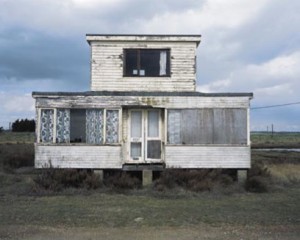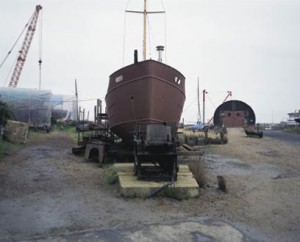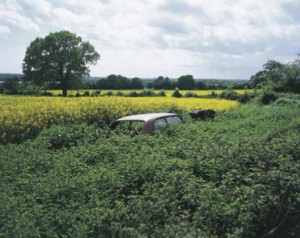words by Ken Worpole, photos by Jason Orton
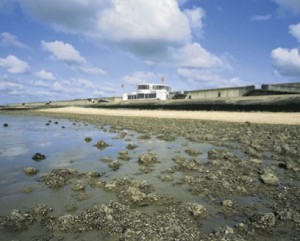
Seawall kiosk/restaurant Canvey Island
In January 2005 I was contacted by the photographer Jason Orton asking if I would collaborate with him on a new project. He had been commissioned to produce a series of photographs of the Essex coastline by ExDRA, the Essex development agency. He asked if I would contribute an essay on the history and topography of the landscape, which I was delighted to do. Over the next three months we travelled much of the 350 miles of the coast by foot, bicycle, and on one occasion – the only time we travelled together, as it happened – by car. Although we communicated frequently between visits, discussing places we had been, it was always understood that the photography and the writing were being pursued independently – each according to our own distinctive interests and obsessions.
On publication a number of reviewers or commentators remarked how well they matched, and it is pleasing to record that this was wholly a matter of shared, elective sympathies, rather than brute aesthetic force. This is not to say that there was no editorial judgement involved in the final publication, far from it. The essay had certainly picked up on some of the places Jason had enthused about or found especially mysterious, whilst on several occasions I pointed him in the direction of places which over the years held a particular appeal to me. So there was a degree of inter-weaving of themes and places before the final editing took place.
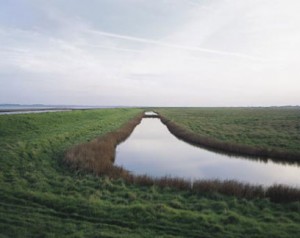
Tollesbury Wick Marshes, Tollesbury
There was one difficult editorial decision to be made, however, not without anguish, and that was whether to include any of the portraits which Jason had taken. These were of some of the people he had met in his travels – a boat-builder, a Salvation Army Captain, a well-known gardener, a gallery director – amongst others. Try as we may, we couldn’t make these portraits fit. For as we quickly came to realise, both Jason’s photographic point of view and my essay, were based on a sense of distance (though not detachment). Distance of space, distance of time. The portraits brought us too close in: broke the spell, disrupted the reverie we were each trying to create.
This does not mean that ‘350 miles’ is depopulated. The ghostly presence of human activity is to be found everywhere on this extraordinary coastline, and along its great estuaries, along with the ruins of past epochs and battles, buildings and boats. The water’s edge proved for both of us to be a memory theatre, a place of constant shape-shifting and evocation of past lives.
My family moved from Leytonstone in east London to Canvey Island in Essex in 1950, when I was six years old, and my brother a baby. Our father rented a small timber bungalow in Grafton Road, only a few hundred metres from the sea wall, then moved us all to Hadleigh, a small town several miles further along the Thames coast. On Canvey Island I spent a year at Long Road Primary School, a fine red-brick building – still in use – surrounded by dykes originally excavated by Dutch engineers. These were rich with dragonflies and other astonishing insects and small reptiles, in amongst the almost impenetrable bull-rushes and other rampant marshland vegetation. The bungalow which became our home for a year was one of many thousands of ‘jerry-built’ or self-constructed dwellings created in this frontier terrain, a four-square, single storey wooden house with a verandah, erected on brick piers about 15 inches off the ground, high enough for a toddler to crawl under from one side to the other, which of course I did. Every house in our unmade road was different, often eccentrically so. The wider landscape had a uniquely industrial, estuarine, wilderness character that was thought to be uncultivated, even wild – as were the inhabitants, it was said.
Moving to Hadleigh we found ourselves living next door to a chapel belonging to The Peculiar People, a Christian sect unique to south Essex, active for much of the 19th and 20th centuries until it joined with the Union of Independent Evangelical churches in 1956. The people who settled in this part of Essex often embodied a pioneering spirit, and a nonconformist religious and political scepticism, still evident. Nothing, I came to realise, was ever quite as it seemed in this extraordinary county. Years later I met my future wife at a folk club in Southend, her own father having moved from London’s Jewish East End in the 1930s. We discovered that, separately and together, over the years, many other people we knew came from similar patterns of migration, from London and beyond. The life of the poet, Denise Levertov, born in Ilford in 1923, acutely registers these migrations and shifting religious and social allegiances. She was the daughter of a Welsh mother and a father who was born a Russian Jew yet became an Anglican priest. Levertov carried her memories of the rivers and gardens of Essex for the rest of her life, despite settling in America where she became one of its most renowned writers, later converting to Catholicism.
Essex, I came to realise, was a bulwark shore, distinguished by its sturdy architecture of sea-walls, lighthouses, forts, tidal defences, gun-emplacements, airfields, Martello Towers, sea-forts, decoys, piers and harbours. Even today military activity remains a background presence along the coast. The sight of a red warning flag when the gun ranges are in use – fluttering high above the entrance to an overgrown lane, or one of the ancient green roads leading down to the water’s edge – is not uncommon. If anything it adds to the mystery and guardedness of these untamed fields, marshes and lonely reaches.
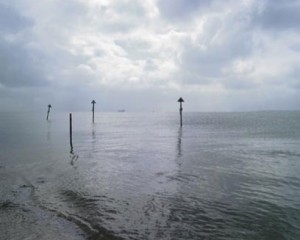
Pool spar markers, Thames river
When the 19th century art critic John Ruskin wrote that ‘mountains are the beginning and end of landscape’, he was, on this occasion, wrong. For some of us, it is at the shoreline that landscape truly begins and ends, where the land meets and inter-penetrates with the sea and the sky. It is also where many geological eras and human belief systems find their fulfilment or nemesis. In his introduction to S.Baring-Gould’s novel, Mehalah, set on Mersea Island in the second half of the nineteenth-century, the writer John Fowles refers to the ‘vast God-denying skies, the endless grey horizon, the icy north-easterlies’ on the Dengie flats in winter.’
For many Victorians the debate about evolution, based as so much of it was on what was being discovered in the fossil record, meant that the sea-shore was a place where revealed religion ended, and self-knowledge began. In the words of the French historian, Alain Corbin, ‘people came to the coasts to browse the archives of the Earth.’ Every beach and smallest of cliff-faces, displayed a geological section or fossil collection that recorded vast eternities of time. This movement from landscape to the interior lives and belief-systems of those affected by it, is a constant theme in the literature and art of the Essex coast and river. The Essex shoreline is a Darwinian test-bed, a place where, if you are looking for something, it will eventually be found, though not necessarily in the shape imagined. These coastal landscapes with their vast skies, uninterrupted horizons at the far edges, glimmering mudflats and estuaries, are distorting mirrors, but mirrors all the same. There are no distractions.
This landscape can be approached in several ways. The visitor can start at the northern limits of the coastline, around Horsey Island in the archipelago of Hamford Water, where Arthur Ransome located one of his most delightful children’s books, Secret Water, then loop round the River Colne, visit Mersea Island, then follow the River Blackwater to Maldon (where the first great epic poem in English, The Battle of Maldon, was set) and out again, past the former Roman fort of Othona, and then on to the remote and eerie Dengie Marshes. Or you might start at the other end, walking out from London along the shore-paths and factory roads which once ran out to the industrial shoreline of Dagenham, to the oil refineries at Coryton (whose flares and lights at night illuminated the skies of many childhoods), and go on to explore the Victorian Coalhouse Fort at Tilbury, designed to defend London from invasion. After that you will come in time to the ruins of Hadleigh Castle looking out across the downs to the Thames estuary. In either direction, every inch of the way represents territory that has been precariously settled, fought over, and on occasions abandoned, over many thousands of years.
Yet traces always remain. The bones of monkeys, bears, elephants and hippopotamuses have been found in the 300,000 year old river gravels beneath the shingle beaches at Cudmore Grove on Mersea Island. The red earthenware pots which were used by the Romans to evaporate brine to make salt, can still be found in broken piles dotted along the shoreline, particularly along the north shore of the Blackwater. There are Romano-British burial chambers on Mersea Island, the largest of which, Mersea Mount, is 100 feet in diameter and 22 feet high. The remains of Charles Darwin’s famous expeditionary ship, HMS Beagle have been found, it is claimed only recently, in a quiet creek off the Crouch Estuary.
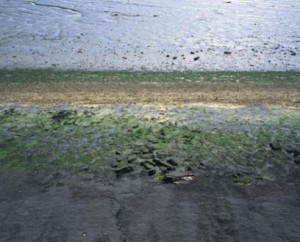
Foreshore strata, River Crouch
The very high tidal levels of the Essex littoral – which result in the landscape being visually different at low or high tide, sometimes unrecognisably so – requires many structures to be built on stilts (as were the seaforts), and to protrude even further into the sea than might otherwise be thought sensible. Tidal settlements and communities have to adjust to two different worlds, operating to two different timetables and ground levels, thus retaining elements of a much older kind of human geography: time and tide.
Some coastal residents still live and flourish in house-boats, permanently moored down tiny creeks and rivers, or on mud-berths close to the shore-line. When he rented a cottage on the Dengie Marshes in the early 1980s to write Coasting, author Jonathan Raban noted that a number of houses had been cobbled together out of bits of old boats, and that ‘this architectural absentmindedness about what properly belonged to the sea and what to the land was just one symptom of the general elemental confusion here on this boggy fringe of things, where England petered out into water and water petered out into England.’ There seem to be as many boats on mud and land in Essex as there are in the water, sometimes in a state of mid-repair, or slowly turning from boat to house or shed, and sometimes back again.
Essex has also provided fertile ground for a number of artists in the 20th century, notably Edward Bawden, Eric Ravilious and John Aldridge, who settled with their families in or close to Great Bardfield in the 1930s, and from there produced a stream of paintings, lithographs, and block-prints which helped define Englishness between the two great wars, and after. The watercolours Ravilious completed in the 1930s revealed a delight in higgledy-piggledy farmyards, allotments, pigeon-coops, abandoned farm machinery, the carcasses of old cars and buses, lying at the edges of fields edged by elms and poplars.
Bawden was more inclined to the pre-occupations of the English Neo-Romantics at this time, and to the use of linocuts and woodcuts, as well as watercolours and oils. His watercolour, Essex Landscape of 1936, is rich in autumnal greens and browns, along with the skeletal forms of dying trees. During and after the war his work becomes more peopled, and communal, with scenes from active army service and then village life. In 1949 Penguin Books published a collection of sixteen lithographs by Bawden, of village scenes, largely based on places in Great Bardfield, called Life in An English Village, with an introductory essay by Noel Carrington. In the immediate post-war period, the Essex village and landscape, the latter with its distinctive mixture of arable farming, smallholdings, disused airfields, pillboxes and coastal defences, came to represent a new genre of English landscape. The Essex landscape now stood for a more vernacular, resilient Britain.
In 2005 the New York Review of Books reprinted in its series of classic writings from the 20th century, a little-known book called The Peregrine by J.A.Baker, an Essex librarian of whom, sadly, too little is known. The new edition has again helped to dispel the myth of the post-war Essex landscape as being a dull mono-culture of arable farming, suburban sprawl, and wind-swept bypasses. For Baker, the Essex woods and sea-shores were Shakespearian in their mystery, Ardens and Edens, protean places inhabited by extraordinary creatures engaged in a cyclical story of birth, the struggle for survival, settlement, predation and victory in death.
Yet for most people, he believed, this world exists unseen. Baker called it a ‘beyond world’, which took place in the skies above, in the undergrowth, in the hedgerows and forest cover. This is the world inhabited by the birds and smaller animals, and carries on with a colour and drama, only revealed to those who spend time in the fields and copses, patiently observing. In The Peregrine, Baker detailed the events of one winter season. He watched and recorded the activities of one pair of peregrine hawks – who became his own familiars – as they covered a territory of some ten miles of estuary and its hinterland. Day by day he followed them on bicycle and foot, recording their each and every activity – washing in small streams, roosting in trees, rising high into the sky to patrol their territory, and then plunging for the kill. The remains of the eviscerated victims were sought out and annotated, feathers, bones, blood and all.
Baker’s prose style, and sensibility, had much in common with the poetry of Ted Hughes if anything, Baker was even more ferocious in his identification with the animal world. Yet he could also express great feelings of happiness at times, as he seems to do in the valedictory sentences at the end of A Hill in Summer, his last published work. ‘My life is here,’ he wrote, ‘where soon the larks will sing again, and there is a hawk above. One wishes only to go forward, deeper into the summer land, journeying from lark-song to lark-song, passing through the dark realms of the owls, the fox-holdings, the badger-shires, out into the brilliant winter domain, the sea-bleak world of the hawks.’
In the writings and observations of Baker and other naturalists, as well as contemporary environmentalists, one can begin to see that it is only in the smallest details of highly localised micro-geographies or habitats, that landscape truly differentiates itself. This is especially true of riparian and estuarine landscapes, which change not only with the ebb and flow of the tides, but with the movement of the clouds and skies, as well as with the seasons.
The Essex coast in winter is the best season for observing bird-life in its entirety. Many seabirds and waterfowl over-winter along the estuaries to escape from the extreme weather conditions of their native breeding grounds, to which, however, they return in Spring. At times it is possible to see great clouds of Brent Geese darken the skies above the Blackwater, screaming as they flock from one stretch of marshland to the next. Summer brings its pleasures too, not only in the annual migration of nightingales to Fingringhoe and elsewhere, but in the many flat stretches of pasture-land or headland grass – Cudmore Grove is a favourite habitat – where skylarks ascend into the high skies, singing constantly, before plummeting to the ground and starting all over again.
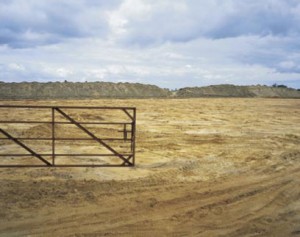
Sand extraction plant, Fingringhoe
Landscapes change, and attitudes to what is thought desirable and beautiful in landscape change with them. The writer Robert Macfarlane, who provided the elegant introduction to the reprint of The Peregrine, has argued that different periods and temperaments favour different landscapes. For the more courtly or baroque sensibilities of the 17th and 18th centuries, mountains were an abomination, chaotic, order-less, and unquestionably to be feared. The Romantics subsequently worshipped them as we know, and found in the snowy peaks and grandeur of high places, a sense of the ineffable. The traumas of the First World War privileged within the Edwardian imagination the lawns, cricket-greens and churchyards of England’s deep green interior: with limpid evocations of Cotswold villages, chalk streams, gazebos and terraced rose gardens. The Second World War, with its greater emphasis on the democratic and the vernacular, turned to the working landscapes and blunt fortified coast-lines of southern England as places of record and celebration once again.
Much of the industrial shore-line of Essex has now been flattened. There are no great cliffs or mountain ranges in this part of the world, nor any man-made towering infernos – though there are ruins. It is principally a world of horizontals, best seen from the narrow aperture of a bird-hide, or looking out at a grey sea where the masts of distant coasters slowly crawl from one side of the horizon to another. These vistas can last a lifetime, and sometimes do.
Copies of Ken Worpole & Jason Orton’s book, ‘350 Miles – An Essex Journey’, are available from the Caught By The River shop.
thanks to Jane for bringing it to our attention
